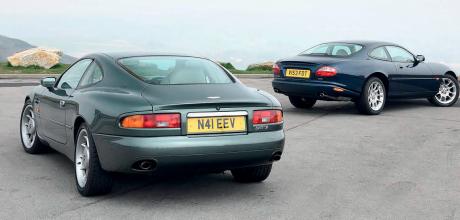1995 Aston-Martin DB7 3.2 Automatic vs. 1998 Jaguar XKR 4.0 X100
As supercharged grand tourers, not only are the Aston Martin DB7 and Jaguar XKR similar in concept but, due to their joint Ford parentage, they share much below the surface. The pair even arrived around the same time, too. We get an early example of each side-by-side to look at these similarities as well as their many differences.
WORDS AND PHOTOGRAPHY: PAUL WALTON
Although they share a little of the same DNA, the DB7 and XKR are two very different cars. But which do we prefer?
BLOOD BROTHERS
Twin test DB7 3.2 VS XKR 4.0
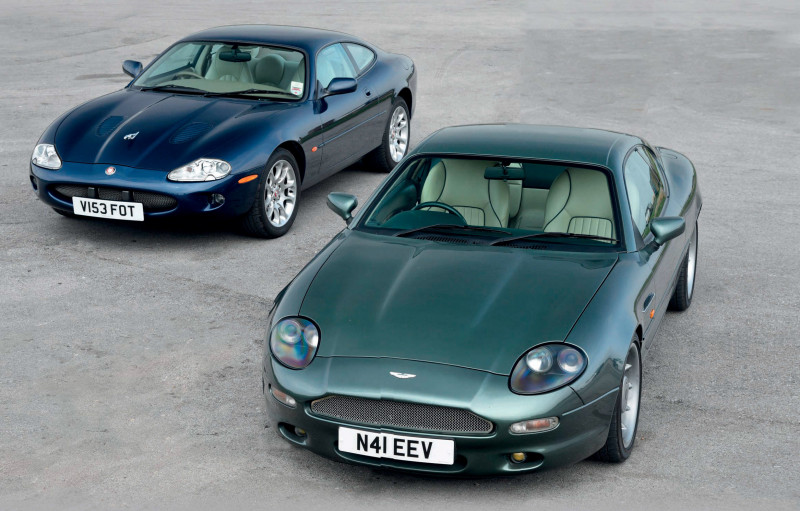
The mid-Eighties, Ford had grown into an enormous empire. As one of the largest automotive manufacturers in the world, it boasted production plants on all continents and sold cars in every country. It also produced an unrivalled array of models. From the popular Fiesta hatchback to the all-conquering F-Series pickup, and the ground-breaking Transit van to a huge range of tractors, there was no market lacking the presence of the famous blue oval.
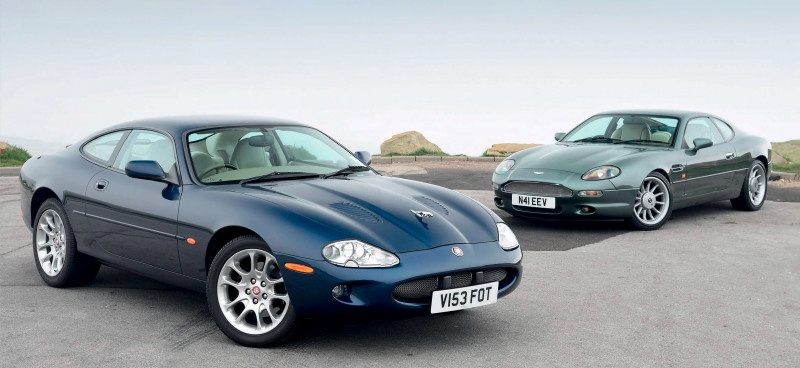
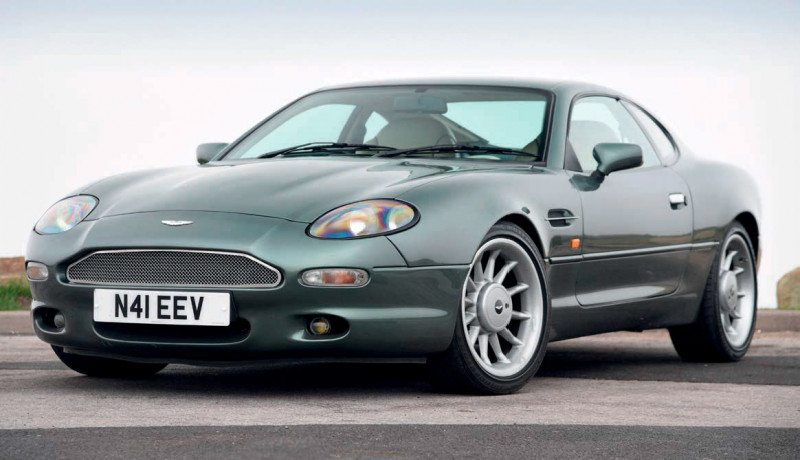
One thing the American giant didn’t have, though, was a great deal of class, especially in the European luxury and sports sector. Although it owned the Lincoln and Mercury brands (the former bought in 1922, the latter created by Edsel Ford in 1938), these were seen as American cars produced for the home market, as was – despite its fame – the Mustang. Meanwhile, Ford’s homegrown European luxury car – the Granada – was losing ground against German marques that were quickly becoming synonymous with style, performance and reliability.
“Unbeknown to everyone at Jaguar, Walkinshaw had approached Ford with the idea of rebadging it as an Aston Martin”
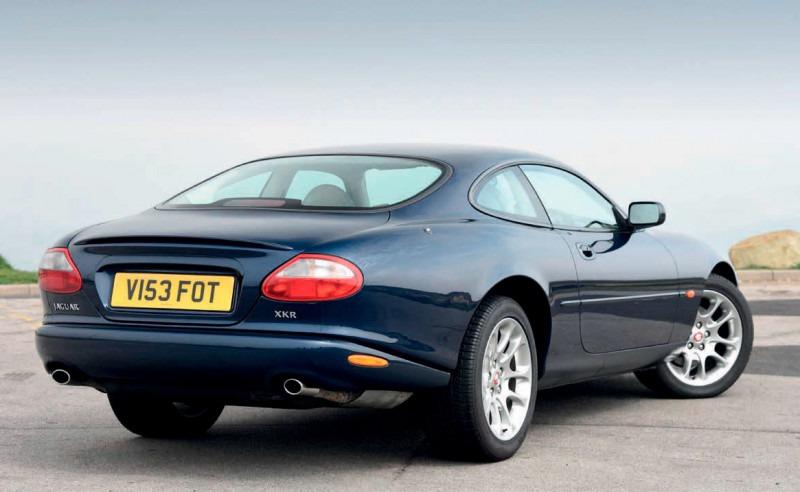
Rather than establish a new brand as Toyota had with Lexus, Ford preferred to purchase down-at-heel European brands, and what they lacked in cash, they made up for with unbeatable pedigrees. The first was Aston Martin in 1988, followed by Jaguar the following year. Keen to capitalise on its investment, Ford wanted new sports models from both, which were to arrive close to each other in time, and even closer in concept.
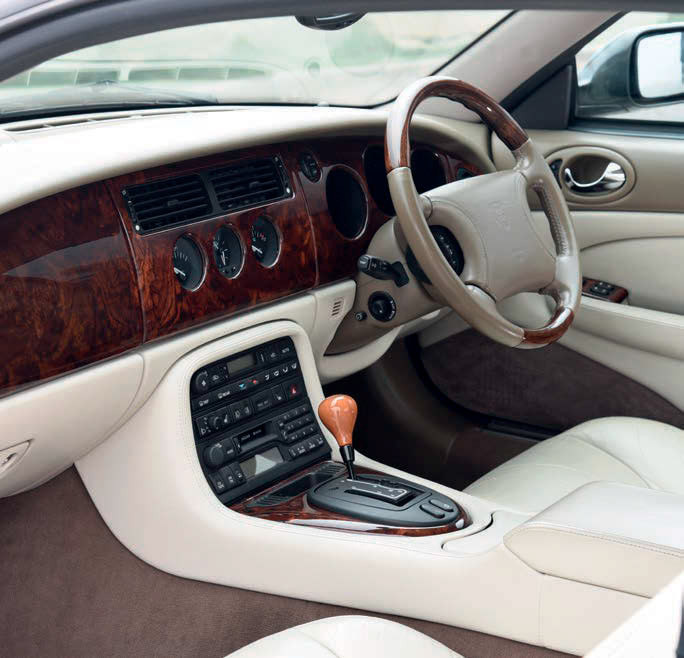
The first to arrive was the Aston Martin DB7. Although it went on sale in 1994, its origins went much further back, to the early Eighties and another British manufacturer.
In 1980, Jaguar’s chief engineer, Jim Randle, realised that if there was a sports car based on the same chassis as the forthcoming XJ40, then parent company British Leyland was more likely to hand over the £80m needed to finish its development of the new and important saloon. So, Randle asked Jaguar’s studio team for a design that he could add to the technical briefing he would give the BL board at London’s Grosvenor Hotel in 1980. Although designer Keith Helfet had only been with Jaguar since 1978 and had to that point only been involved with some of the XJ40’s detailing, such as wheels and door handles, his submission was the one eventually chosen. With smooth, voluptuous lines that were clearly reminiscent of the E-type, it was considerably different from the car it replaced, the XJ-S.
The plan worked, and BL released the money, meaning that while the XJ40 neared production, Keith was able to further develop his sports car (internally codenamed XJ41 until the press got wind of it, when it was unofficially nicknamed the F-type).
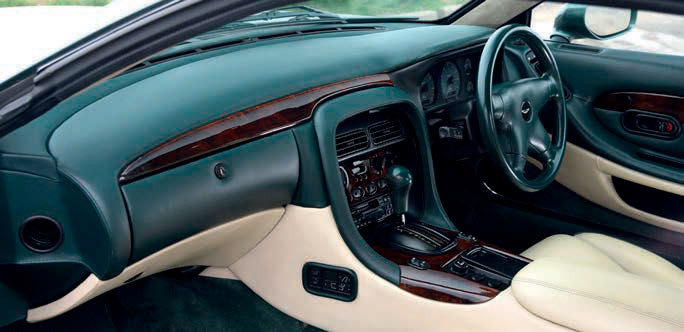
By the mid-Eighties, development of the XJ41 was progressing and several running prototypes had been produced by the German contract engineering specialist, Karmann. Powered by a twin-turbocharged version of Jaguar’s 4.0 straight-six, resulting in 330bhp, they were very fast. Yet speed and beauty wasn’t enough to stop Ford canning the car in 1990. Jaguar’s new parent company considered the XJ41, with its all-wheel drive, to be too heavy, too complicated and too expensive to put into production. However, the project didn’t end there.
Helfet, who had spent the best part of a decade working on the car, wanted to see his design reach production and began investigating whether the XJ41’s body would fit onto the XJ-S chassis, thereby creating a new car with very little outlay. It did, so Randle took the idea to the board of JaguarSport (a separate company owned 50/50 by Jaguar and TWR to produce sportier models). TWR’s boss, Tom Walkinshaw, immediately saw its potential and agreed to JaguarSport building it, saving the project.
Although development was now with TWR, the car remained a Jaguar and rechristened Project XX. But that soon changed. Unbeknown to Helfet, Randle and everyone else at Jaguar, Walkinshaw had approached Ford with the idea of rebadging it as an Aston Martin. The Newport Pagnell-based marque was seen as more exclusive than Jaguar, which meant it could charge a higher price for the same car, and Ford readily agreed.
What with the XJ220’s high development costs and in the wake of the economic downturn of the early Nineties, Ford had not wanted to pay for a new Aston Martin model, so a car that had already had much of its development paid for by someone else was the perfect solution.
Renamed once again, this time as Project NPX (for Newport Pagnell Experimental, even though it would be built at TWR’s facility at Bloxham), the first task was to make the design more like an Aston Martin. This fell to a former Ford designer, Ian Callum, who had joined TWR in 1990. “I had references to Aston in my head,” said Callum in Andrew Noake’s 2006 book, Aston Martin DB7, The Complete Story, “visions of DB4, DB5, DB6 and Zagato. The Zagato was one of the biggest influences on the shape of the NPX; it had a much more voluptuous feel about it. I felt it would be easier to follow some of that than the purity of the DB5.”
The biggest changes that Ian made to the design were to the screen, pulling it further forward, plus adding the famed Aston Martin grille; he had spent a lot of time analysing its shape, which was first seen on the 2.0-litre Sports of 1950 and which started as a large, upright radiator grille with two smaller cooling grilles low down on either side. Eventually, the two small apertures were merged into the larger one and the resulted shape became lower and wider, and it became the first car to use the definitive grille that we know today was the DB3S racing car of 1953. “It took me ages to get right,” said Callum. “It’s immensely sensitive.”
Because Ford was adamant on keeping production costs down, Aston’s engineers were forced to raid the expanding company’s growing parts bin. The rear taillights came from the Mazda 323F (Ford had starting buying shares in the Japanese company in 1979, owning as much as 33.4 percent by 1995), the chrome door handles were from the Mazda 323 estate, and the turn signals from the Mazda MX-5, while much of the interior switch gear was sourced from Ford itself. The wing mirrors were the only foreign parts, which came from the Citroën CX. As a result of this parts recycling, the project cost a mere $30 million, pocket change for a new car, even at the time. Despite the penny pinching and outsourced parts it was a very beautiful car, one that had its own character and that hid its Jaguar parentage well. It looked as if it were a direct descendent of the acclaimed DB family. Little wonder, then, that when the still-unchristened car made its debut at the 1993 Geneva Motor Show, the reception was so positive that there was only one name suitable: the DB7.
It was originally mooted that the car would be powered by a V12, although in the end was the familiar straight-six. Continues Callum in Noakes’ book, “Walter Hayes [Aston Martin’s then chairman] wanted to do the six. He had a price bracket in mind and the V12, I think, was just too expensive.” A six also fitted in with Hayes’ view that the new car should be a true successor to the classic DB Astons of the Sixties and Seventies, which were all powered by a straight-six. “I very much wanted an engine that carried DBism,’ Hayes had said. “We were continuing a distinguished heritage. If you don’t respect the heritage you should go and work for someone else.”
Hayes originally looked elsewhere for the block, talking to Mercedes-Benz (ironic, considering Aston’s current technical partnership with the German company) and BMW, but in the end returned to the Jaguar AJ16 engine. Again, being from part of the Ford empire, it was the cheapest option, yet there were also some engineering advantages: it had been used in the XJS and XJ41 which meant there was plenty of knowledge about fitting the engine into the chassis. To increase power, Hayes wanted the engine to feature forced induction, although not the turbocharged version developed for the XJ41. He was aware of the work that Ford had undertaken alongside the American company Eaton for the tenth generation of the Ford Thunderbird from 1989, and preferred supercharging. Consequently, the M90 – the second biggest of the four superchargers that Eaton produced – was chosen.
The 3,239cc version of the AJ16 that had never been available with the XJS was used for the new Aston but with shorter pistons which lower the compression ratio to 8.5:1. There was also a TWR-designed, four-valve cylinder head, while the block featured detailed differences in the machining compared to the Jaguar unit. The result was 335bhp and 316lb ft of torque, slightly more than Aston’s own 5.3-litre V8 that was currently in the Virage and more than Jaguar’s 6.0-litre V12.
However, the engine sat too high and was proud of the bonnet line. Since a power bulge was considered too Jaguar-like, the only solution was to drop the motor — achieved by redesigning the front subframe, which carried both the suspension and engine mounts. After heavy lobbying from Callum, the rear suspension was also modified to improve the car’s stance.
The result was a car that, although technically based on a Jaguar, featured many unique components, making it a model in its own right.
Fast, beautiful and well-engineered, little wonder the car became a hit with the critics when it was released in the second half of 1994. “Even without the emotional knee-jerk reaction to a car of such beauty, the DB7 is triumph,” announced Autocar in its October 1994 issue. “On nigh-on every area of engine and chassis performance, it has what it takes to hold its own against the opposition and, in many ways, show them the way home.”
It needed to be good. At £78,500, the DB7 was £4k more than the Mercedes-Benz S500C C140, £6k more than the Porsche 928 GTS and a whopping £30k more than the XJ 6.0 V12. The latter, of course, wasn’t too much of a worry; it might have shared much with the DB7, but the Jaguar was perceived as a much older car. The XJS was coming to the end of its life and, behind closed doors, Jaguar was busily working on a replacement.
The cancellation of the XJ41 was a major cause of concern for Jaguar, leaving it without a successor to the already ageing XJ-S. A stopgap solution was to give the old car a major facelift for 1991, yet it went beyond just newer, more modern horizontal rear lights and new instrument panel with six traditional round dials instead of the infamous tumblers of the early cars. Of the car’s 490 panels, 180 were replaced or modified, to improve the fit, finish and durability of the bodyshell. The AJ16 3.6-litre straight-six was replaced by the new 4.0 AJ6 unit and the car had the option of ZF’s uprated 4HP24 automatic gearbox or Getrag’s manual five-speeder. There were also new alloy wheel designs, more modern body colours and better detailing, including a new badge on the boot lid since the hyphen in the car’s name was deleted. Visually, the changes were minor, but the improved build quality beneath the surface did much to increase the car’s desirability and, therefore, sales showed a marked improvement, from 3,638 in 1992 to 6,643 in 1994. Yet there was no getting away from the fact that it was an old car and it needed replacing.
Work on a successor – codenamed X100 – began in 1991. After 20 years of the XJ-S’ hard, angular lines, there was a feeling by both Ford and Jaguar’s management that the new car should go back to the softer curves that the company was renowned for. Explained Jaguar’s then design director, the late Geoff Lawson, in the 6 March 1996 issue of Autocar, “Internally, we had a very strong view that the XK8 ought to be the spiritual offspring of the E-type, with muscular flowing shapes and a much sportier look than the XJS.” That didn’t stop the designers investigating many other designs, though, including one that took inspiration from the XJS. In the end, however, another classic design by Keith Helfet won out, although the project was taken through to production by his colleague Fergus Pollack. With Helfet using the same points of reference for this car as he had for the XJ41, it meant that the new model bore a strong resemblance to the DB7, especially the front and rear arches’ smooth, flowing shapes. Lawson played down the comparisons in the April 1996 issue of Car magazine, saying, “The similarities between the XK8 and XJ41 are only spiritual.”
Due to the lack of funds, something else the car shared with the DB7 was the use of the XJS’ chassis – well, part of it – something that didn’t especially worry Lawson. “It’s a fact of life,” he said in the same interview, “So no major issues. Every designer has to deal with it. It’s part of the patch, like legislation. You don’t like it, it’s constraining but you just take it on board.” Asked about the changes that were made to the chassis for the new car, he explained, “We wanted to have a more efficient ratio of interior to exterior. So we made it shorter, but about the same width.”
At its heart was an all-new V8, its compact size allowing the car to have shorter dimensions than its predecessor. Lawson explains his thinking in another 1996 interview. “V8 engines are shorter than straight-sixes, so it made sense to physically shorten the XK8’s bonnet. That, in turn, allowed us to move the windscreen forward, creating a much faster and more interesting profile.”
The 3,996cc, quad-cam, 32-valve V8 was designed inhouse, but built at Ford’s power plant factory at Bridgend, in Wales. Because of its compact nature, compared with a straight-six or a V12, rigidity is increased in V8 format, giving potentially better refinement, while its smaller surface area radiates less heat, leading to a shorter warm-up period and, therefore, lower emissions. Also, market research had revealed that the majority of potential customers, both in Europe and the US, preferred a V8 to any other configuration.
Other variations were discussed, as David Szczupak, the AJ26’s chief architect, explained in 1996. “We considered all types of alternative line-ups, from V10s and 4.0-litre V12s, flateights and flat-sixes, to straight-sixes and V6s. We gradually narrowed these down to a possible three-engine range of V6, V8 and V12. AJ26 was the code name – the number was simply the addition of six, eight and 12.”
The result was a refined, yet powerful, engine that with 290bhp put it among its peers. This was increased to 370bhp in 1998 with the supercharged XKR, which – just as with the Aston – used an Eaton supercharger to eke out more power, but not at the expense of the engine’s smoothness or economy. Its limited 155mph top speed might have been the same as the XK8’s, but its 0-60mph time of just 5.2 seconds made it Jaguar’s first car to off er supercar-like performance since the XJ220.
Yet, at £60k for the coupe (the convertible that arrived the same time was £7k more), it was extremely good value, being £18k less than the Aston, £20k under the Mercedes-Benz SL500’s price and £5k less than the Porsche 911 Carrera. That price difference continues today. Whereas an Aston Martin DB7 3.2 coupe starts at £20,000 and rises to £30,000, you can pick up an XKR 4.0 coupe for less than £10k, rising to between £15k for a good one. Yet bearing in mind its mixed parentage and use of out-sourced parts, did the Aston deserve this difference when new and does it do so today?
There’s only way to find out. Maybe part of the reason why the Aston is worth more is simply because it was built in much smaller numbers. With a production run of 7,141 (1,605 of which were 3.2 coupes), although it was the company’s bestselling car until it was replaced by the DB9 in 2004, but it still pales in significance compared to the 90,374 X100s (23,098 of which were XKR 4.0s) that were made at the company’s now demolished Browns Lane plant.
Due to this rarity, the DB7 isn’t a car I’ve got close to in a while and I admit to being entranced by this gorgeous Aston Racing Green example (similar to the DB4 on page 66 of this issue) that I’ve arranged to drive. I’d forgotten how perfect its proportions are, how the Aston grille suits the low nose and how the rear window narrows at the bottom to create a beautiful curve that meets the wide rear wheelarches. It is – dare I say – slightly better looking than the XKR that’s parked alongside. Not that the Jaguar is ugly, as this gorgeous 1999 Sapphire Blue example shows, but I think its boot line is a little too tall and too long, and the grille too low. And they might have been sourced from Mazda, but the Aston’s slim, wrap-around rear light clusters perfectly match the Aston’s pert rump and are more interesting than the XKR’s conventional lens. Yet, due to the similarity of their design themes – the shape of the front and rear arches especially – it’s clear that the cars are connected, a feeling heightened by the overall dimensions. At 4,760mm, the XKR is a mere 114mm longer than the Aston.
One area where the Jaguar clearly beats its cousin is the interior. Whereas the switchgear in the Aston has clearly been taken from Ford, making the centre console appear as if it’s been directly lifted from a Nineties Escort and I swear the six-clock dial pack is identical to the one in the facelifted XJ-S, the Jaguar’s dash is totally bespoke. I’m sure what’s beneath also comes from Ford, but the bits you see, the three dials located directly into the veneer of the spitfire wing-shaped dash and the admittedly complicated centre console, were all new at the time. And although the standard of the Connolly leather and veneer is better in the Aston than that found in the XKR, the overall build quality of the Jaguar is superior. The lines between the individual interior panels are tighter and more consistent and there are fewer areas where corners and, therefore, costs have been cut.
Both cars offer large, comfortable seats to sink into and both have terrible rear legroom, making the back seats unusable beyond offering just extra luggage space. Time to take a drive. I chose the Aston first; it’s been over 20 years since I last drove a straight-six DB7 and I’m excited to become reacquainted. Yet, as I turn the Ford-sourced key in the no-doubt Ford-sourced ignition, the engine has the same, familiar raspy note as every AJ16-engined XJS I’ve ever driven. This example has the four-speed GM-sourced automatic ‘box, so I slot it down into drive, release the fly-off handbrake located to the right of the driver (the biggest visual giveaway the DB7 uses the same chassis as the XJS as the same location does in the XKR), squeeze the throttle and the engine responds instantly. It’s noisier than the Jaguar’s refined V8, the supercharger whine much more pronounced, but although it has 40 less bhp its performance is harder, rawer, more edgier. On an empty road, I push the throttle further and although even by Nineties standards the idea of a four-speed ‘box in a luxury GT is as old fashioned as running board or starting handle, the transmission changes quickly and precisely, aiding the long pull of acceleration. The Aston feels firmer than the car it’s based on plus the XKR, lacking the suppleness you’d expect from a large, luxury GT like this. As a result, it doesn’t ride over imperfections quite as cleanly and you can feel everything in the cabin. But body roll is better controlled than the XJS, resulting in the ability to take corners faster. The steering is sharper, more accurate, and makes the DB7 feel more a sports car.
Arguably more so than the XKR, too, its handling being more comfortable than the Bloxham-built car. That’s because every supercharged X100 came with Jaguar’s clever CATS (computer active technology suspension) system as standard, which leaves the big Jaguar less skittish than the Aston, but also not quite as sharp. What it lacks in bite, though, the Jaguar makes up for in comfort and, in my opinion, would be the better option of the two for long-distance journeys. Although grip is high, since the steering isn’t as precise as the Aston’s, feeling slightly woolly, and the body roll is a little more pronounced, the XKR doesn’t enjoy being pushed through corners quite as quickly.
One area the XKR doesn’t lose out on to its cousin is its easily accessible power. Thanks to the responsiveness of the 4.0-litre engine, especially when the big Eaton supercharger comes on song – which, along with the engine, is less audible than in the DB7 – when I squeeze the throttle, the V8 responds instantly. The Mercedes-Benz sourced five-speed ‘box (chosen since the ZF unit in the XK8 wasn’t strong enough for the XKR’s extra power) kicks down quickly, resulting in a surprisingly forceful acceleration for a car coming up to two decades old; at 5.2 seconds, it reaches 60mph half-a-second faster than the already-fast DB7. But there’s more to the XKR’s performance than just figures. The V8 is more refined and its power delivery smoother than the Aston’s hand-me-down straight-six. The DB7 might have cost more money when new, but even 20 years later it’s clear the Jaguar was the newer, better developed car, with a better standard of finish. Slightly iffy build quality aside, there’s no denying the continuing allure of the DB7.
Its svelte design still has the ability to stop traffic and there’s a certain mystique about the winged Aston Martin badge, more so than with the Jaguar Growler.
But I don’t think this warrants the Aston’s higher values both then and now. Yes, the DB7 is rarer, which always adds a little, but the two have such similar designs, personalities and performances that it’s hard to distinguish between them. Plus, with the XKR being better built and using fewer borrowed parts than the DB7, resulting in a better pedigree, you have to wonder why there’s any difference at all. It’s due to this price difference why (and I promise this isn’t because I have normally aspirated version at home) I’d choose the Jaguar. Just as when they were new, it’s better value than the Aston.
Costs aside, both cars achieved what Ford wanted, giving the company a major foothold in the luxury sector. More importantly, they also – along with some heavy investment from the parent company – helped safeguard these two historic companies for the future. For DB7 and XKR servicing and repairs, contact KWE www kwecars.com.
TECHNICAL DATA Aston-Martin DB7 3.2
- Engine: 3,239cc, 6cyl SC
- Max Power: 335bhp
- Max Torque: 361lb ft
- 0-60mph: 5.8secs
- Top speed: 165mph
- Transmission: 4-spd auto
- Price new: £78,500
- Value now: £20,000-£30,000
TECHNICAL DATA Jaguar XKR 4.0 X100
- Engine: 3,996cc, V8 SC
- Max Power: 370bhp
- Max Torque: 387lb ft
- 0-60mph: 5.2secs
- Top speed: 155mph (limited)
- Transmission: 5-spd auto
- Price new: £60,105
- Value now: £10,000-£15,000


